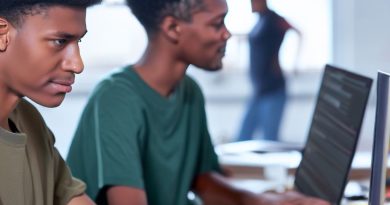Transitioning from Scratch to Python: A Seamless Journey.
Last Updated on September 24, 2023
Introduction
Briefly explain the popularity of Scratch and Python as programming languages for beginners
Scratch and Python are both incredibly popular programming languages for beginners.
They are widely used in educational settings to teach coding concepts in a fun and interactive way.
Scratch, developed by MIT, uses a block-based interface that allows users to drag and drop code blocks to create programs.
It is designed to be user-friendly and accessible, making it a great choice for beginners.
Python, on the other hand, is a versatile and powerful programming language used in various industries.
It has a syntax that is easy to read and understand, making it a popular choice for both beginners and experienced programmers.
The purpose of the blog post: to guide and provide tips for transitioning from Scratch to Python smoothly
The purpose of this blog post is to provide guidance and tips for transitioning from Scratch to Python smoothly.
We will explore the similarities and differences between the two languages and provide strategies for a seamless transition.
Whether you are a student learning to code or an educator guiding students in their coding journey, this post is for you.
By the end of this blog chapter, you will have a clear understanding of how to effectively transition from Scratch to Python.
Transitioning from Scratch to Python: A Seamless Journey
Transitioning from Scratch to Python can significantly enhance your programming skills and open doors to endless possibilities.
While Scratch may be a beginner-friendly programming language, its limitations make transitioning to Python a logical step forward.
Let’s delve into the reasons why you should make this transition and the advantages it brings.
Discussing the limitations of Scratch
Scratch is a programming language primarily designed for beginners, offering a drag-and-drop interface that simplifies coding concepts. However, Scratch has its limitations, including:
- Limited complexity: Scratch is suitable for basic programs but lacks the complexity required for advanced projects.
- Less flexibility: Scratch enforces a specific set of blocks and rules, restricting your programming flexibility.
- Not widely used: Scratch is predominantly used by novices and is not as prevalent in the professional programming world.
- Limited real-world applications: While Scratch is excellent for learning, it’s less applicable outside educational environments.
These limitations make Scratch an ideal starting point but eventually necessitate a transition to a more robust programming language like Python.
Highlighting the advantages of Python
Python offers numerous advantages that make it an excellent choice for further learning and real-world applications. Here are a few:
- Powerful and versatile: Python is a high-level language capable of handling complex tasks and versatile enough to be used in various domains.
- Large community support: Python has a vast and active community, providing abundant resources, libraries, and frameworks.
- Better job prospects: Proficiency in Python is highly sought after in the job market, with many career opportunities available.
- Scalability and performance: Python’s efficient code execution and scalability make it viable for projects of any size.
- Real-world applications: Python is extensively used in fields like data science, web development, and artificial intelligence.
By transitioning to Python, you unlock a more expansive programming landscape, enabling you to tackle advanced challenges and work on real-world projects.
Emphasizing the importance of expanding knowledge
Expanding your programming knowledge is crucial for professional growth and staying relevant in the ever-evolving tech industry.
Transitioning to Python marks a significant step towards mastery of text-based languages, improving your problem-solving abilities and critical thinking skills.
Moreover, learning Python sets a solid foundation for tackling other popular languages like Java, C++, or JavaScript.
By familiarizing yourself with Python’s syntax and concepts, you’ll find it easier to adapt to new languages and frameworks.
Transitioning from Scratch to Python is a seamless journey that propels your programming skills to new heights.
While Scratch is a great starting point, Python overcomes its limitations, providing more versatility, wider job prospects, and real-world applications.
Expanding your knowledge by embracing Python opens doors to endless possibilities in the exciting world of programming.
Read: From Zero to Hero: Success Stories from Popular Coding Websites
Understanding the Similarities and Differences
Explore the common concepts shared between Scratch and Python
When it comes to learning programming, transitioning from one language to another can be a daunting task.
However, if you have experience with Scratch, learning Python can be a seamless journey.
In this section, we will explore the similarities and differences between Scratch and Python, focusing on how Python builds upon the foundation laid by Scratch.
One of the first things you will notice when moving from Scratch to Python is the common concepts shared between the two languages.
Both Scratch and Python use variables to store and manipulate data.
They also both use loops to repeat a set of instructions and conditionals to make decisions based on certain criteria.
These concepts serve as a solid foundation for understanding programming principles and can easily be transferred from Scratch to Python.
Explain the syntax differences between the graphical interface of Scratch and the text-based syntax of Python
However, the syntax of Scratch and Python differs significantly.
Scratch uses a graphical interface where you drag and drop blocks to create programs, while Python uses a text-based syntax where you write code using words, symbols, and punctuation.
The transition from the graphical interface of Scratch to the text-based syntax of Python may feel overwhelming at first.
But once you understand the basic structure of Python code and familiarize yourself with the syntax, you will find that it offers more flexibility and control over your programs.
How Python builds upon the logical thinking skills developed in Scratch
Another crucial aspect of transitioning from Scratch to Python is how Python builds upon the logical thinking skills developed in Scratch.
In Scratch, you learn to think logically by arranging blocks in a sequential order to create a desired outcome.
Python takes this logical thinking a step further by introducing the concept of functions, which allows you to break your code into reusable and modular components.
Understanding how to decompose a problem into smaller, manageable steps is a skill that carries over seamlessly from Scratch to Python.
Transitioning from Scratch to Python is a seamless journey, thanks to the similarities and differences between the two languages.
By understanding the common concepts shared between the two languages, grasping the syntax differences, and building upon the logical thinking skills developed in Scratch, you can effortlessly transition to Python.
So, if you are ready to take your programming skills to the next level, Python awaits you with endless possibilities.
Read: Boost Your Career: 10 Reasons Why Americans Should Code
Transitioning from Scratch to Python: Essential Steps for a Seamless Journey
Transitioning from Scratch to Python can be an exciting and challenging endeavor.
While Scratch offers a user-friendly interface and visual programming environment, Python opens up a world of possibilities with its versatility and power.
To ensure a seamless journey, it is important to follow these essential steps:
Start with simple projects in Python to reinforce basic concepts
One of the first steps in transitioning from Scratch to Python is to start with simple projects.
By starting small, you can gradually reinforce your understanding of basic programming concepts such as variables, loops, and conditionals.
This approach also allows you to familiarize yourself with Python’s syntax and structure.
Try recreating some of your favorite Scratch projects in Python.
While the visual aspect may be missing initially, the satisfaction of seeing your code come to life in a new programming language is incredibly rewarding.
Along the way, you will learn how to translate Scratch blocks into Python code, strengthening your understanding of programming logic.
Familiarize yourself with Python’s IDLE or any other integrated development environment (IDE)
Python comes equipped with a built-in development environment called IDLE. Familiarize yourself with IDLE to write, run, and debug Python code.
IDLE provides a user-friendly interface that allows you to experiment with code and see the results instantly.
Its simplicity makes it an excellent choice for beginners transitioning from Scratch.
Alternatively, there are several other popular IDEs available for Python development, such as PyCharm, Visual Studio Code, and Anaconda.
Explore different IDEs and choose the one that suits your preferences.
IDEs offer additional features like code suggestions, auto-completion, and debugging tools, which can greatly enhance your programming experience.
Reinforce understanding by translating Scratch projects into Python code
Take the opportunity to leverage your existing knowledge of Scratch projects to reinforce your understanding of Python.
Translate your Scratch projects into equivalent Python code. This exercise will help you understand the similarities and differences between the two programming languages.
When translating Scratch projects into Python code, pay attention to the syntax and logic.
While Scratch relies on dragging and snapping blocks together, Python uses indentation and proper syntax to define blocks of code.
Understanding these differences is crucial to a successful transition.
Seek resources and join programming communities to enhance learning and support
The journey of transitioning from Scratch to Python is even more enjoyable when you join programming communities and seek additional resources.
Online forums, discussion boards, and coding communities provide opportunities to connect with like-minded individuals, seek guidance, and learn from others.
There are numerous online resources available to aid in the transitioning process. Online tutorials, video courses, and documentation can serve as valuable references.
You can also explore Python-specific books and guides catering to beginners. The wealth of resources available ensures that there is always something new to learn.
Additionally, consider participating in coding competitions or hackathons.
These events provide practical challenges and opportunities to apply your newfound Python skills.
Collaborating with others and working on real-world projects can further enhance your learning and provide valuable insights.
Read: Automate Your Minecraft Tasks with Python Scripts

Key Concepts to Master
Transitioning from Scratch to Python can be a seamless journey if you understand a few key concepts.
In this blog section, we will explore the essential topics that you need to master to become proficient in Python programming. Let’s dive in!
Data Types, Variables, and Data Structures in Python
One of the fundamental concepts in Python is understanding the different data types, variables, and data structures.
In Python, you can work with integer, float, string, boolean, and other data types.
Variables allow you to store and manipulate data, and data structures like lists, tuples, and dictionaries help organize and manipulate collections of data.
To transition smoothly from Scratch to Python, it is crucial to familiarize yourself with these concepts.
Understanding how to declare variables, assign values, and work with data structures will make your coding journey much easier.
Understanding Functions and Modular Programming in Python
Python offers a vast array of built-in functions, and you can also create your own custom functions. Functions are reusable blocks of code that perform specific tasks.
They help break down complex problems into smaller, manageable chunks.
Transitioning from Scratch, where scripts run linearly, to Python, where functions play a crucial role, requires a shift in mindset and approach.
Learning to define and call functions, pass arguments, and return values is essential to write modular and efficient Python code.
Working with Loops and Conditionals in Python
Loops and conditionals are indispensable tools in programming. They allow you to perform repetitive tasks and make decisions based on certain conditions.
In Python, you can use for and while loops to iterate over data and execute code blocks multiple times.
Conditionals, such as if, elif, and else statements, enable you to execute specific code blocks based on certain criteria.
Mastering loops and conditionals is essential to add logic and control flow to your Python programs.
Exploring Python Libraries and Packages for Extended Functionalities
Python has a rich ecosystem of libraries and packages that extend its functionality beyond the core language.
These libraries provide pre-written code for various domains, making complex tasks more accessible and improving productivity.
As you transition from Scratch to Python, exploring popular libraries like NumPy for scientific computing, Pandas for data manipulation, and Matplotlib for data visualization can significantly enhance your programming capabilities.
Learning how to import and use these libraries opens up endless possibilities for your Python projects.
Read: Building Virtual Worlds: Coding Landscapes in Minecraft
Tips for a Smooth Transition
Transitioning from Scratch to Python can be a seamless journey if you follow these helpful tips:
Practice regularly and allocate dedicated time for learning Python
Transitioning from Scratch, a block-based coding language, to Python, a text-based programming language, may seem daunting at first.
However, by following these tips, you can make the process smoother and more enjoyable.
Regular practice is crucial. Treat learning Python as a habit and allocate dedicated time in your schedule to engage with the language.
Consistency helps reinforce concepts and allows you to progress steadily.
Break projects into smaller, manageable tasks to prevent overwhelm
Breaking projects into smaller, manageable tasks is a proven strategy. When faced with a large project, it’s easy to feel overwhelmed.
By dividing it into smaller tasks, you can approach each one with focus and clarity, gradually building your skills and confidence.
Utilize online tutorials, documentation, and interactive resources
Online tutorials, documentation, and interactive resources are invaluable tools when transitioning to Python.
Take advantage of the abundance of learning materials available on the internet.
Tutorials provide step-by-step guidance, documentation offers in-depth explanations, and interactive resources allow for hands-on practice.
Start collaborating and interacting with Python communities and forums
Additionally, engaging with Python communities and forums can greatly enhance your learning experience.
Participating in discussions, asking questions, and collaborating with fellow learners and experienced programmers exposes you to different perspectives and accelerates your understanding of the language.
Remember, transitioning from Scratch to Python is a journey that requires patience and perseverance.
Embrace the learning process, celebrate small achievements, and don’t be afraid to seek help when needed.
With the right mindset and these helpful tips, you’ll soon find yourself coding seamlessly in Python!
Conclusion
Transitioning from Scratch to Python offers numerous advantages.
First, Python is a widely-used programming language with extensive real-world applications.
By learning Python, individuals can enhance their coding skills and open up new career opportunities.
Secondly, Python allows for more advanced programming concepts such as object-oriented programming, which can lead to the development of complex and sophisticated software.
This transition empowers learners to tackle more challenging projects and expand their problem-solving abilities.
Although the journey from Scratch to Python may seem daunting at first, it is important for readers to embrace the challenge and persist in their learning.
Like any new skill, it requires dedication and practice to become proficient.
By reinforcing the idea that a seamless transition is achievable, readers are encouraged to stay motivated and continue their Python education.
With time and effort, they can master Python and unlock its full potential.
Transitioning from Scratch to Python is a worthwhile endeavor.
The advantages are numerous, the journey is challenging but rewarding, and with determination, anyone can become proficient in Python.
So embrace the journey, practice consistently, and prepare to excel with Python.


